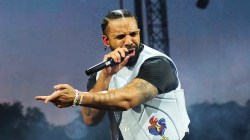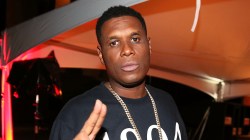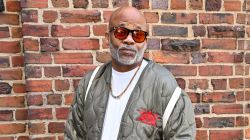Given the antiquated means of getting a record label’s attention by demo shopping, online viral sensations use YouTube to gain traction within the industry thanks to videos for introductory songs that are visually and aurally enthralling. Harlem’s Azealia Banks has had a seesaw experience since her grand arrival in the glow of the limelight via the internet, as the subject of international fervor amongst fashionistas (including partying with designer Karl Lagerfeld), a friendly acquaintance of Kanye West and Diddy and a critically maligned object of controversy. Carrying on the tradition of her neighborhood’s brash and outspoken character, Banks’ public spats with the likes of T.I., Iggy Azalea, Lil Kim and Kreayshawn haven’t thwarted the buildup towards 1991, her first retail release and a precursor to the Independence Day scheduled mixtape Fantasea.
Following in the footsteps of Uptown’s recent rising star A$AP Rocky, Azealia Banks is a young woman reflecting the duality of street smart urban youth who move seamlessly through Manhattan’s high end Soho fashion district. 1991 draws largely from house music designed for free spirited partying, as its title track, “Van Vogue,” the breakout smash “212” and “Liquorice” all convey a Dance themed feeling while each sounding rhythmically distinct from one another, a key ability as the newcomer sets no boundaries by which she can be pigeonholed. If one critique is to be offered, it’s the length of the EP, with only four tracks. For an artist whose buzz is sizeable enough for an EP, upcoming mixtape, and debut album, more content is both welcomed and suggested for her first go ’round.
Azealia Banks has an endearing charm, magnetic glow, and aggressively attitudinal confidence that come together as 1991‘s short collection is equally catchy and unique rendering her one to continue watching. Her self-empowered routine (achieving the rare feat of shine without the cosign of a male heavyweight) is all encompassing and sure to unify multitudes regardless of sexual orientation, gender, and ethnicity. Having studied and learned from women responsible for powerful artistic statements including Grace Jones (evidenced by the EP cover’s homage) and Missy Elliott’s playful flows, she is potentially poised to become a cultural icon for this generation.










One word, “dope!!!”
Cultural icon?
Fuck outta here with that.
shut the fuck up if dont like it stop going to this website u are not a editor so
fuck you kacy, big mouth motherfucker.
i bet you’re a bitch in reality
I’ll check this.
whose dick she have to suck to get this type of review? shes wack b
It’s actually a pretty cool snippet EP. She’s not bad, she reminds me a lot of Missy mixed with MIA. She just needs to stay off twitter…unless she’s promoting. I think people know more about her Drama then they know that she has this EP out.
no no no… this album is not hip hop. she’ll probably chart well…. but i won’t be listening.
1 star..
Dope
i like this
Definitely a nice surprise! I was caught off guard here… She blends 90’s house music with fast raps and she does it well. Throw in some Lil’ Kim and Missy Eliot pizazz and there you have it.
A solid 4 in my book!
love it. she is gonna go far.
its aight
HEEELL Y EEEZZZ NIKKKAS
FINALLY IT HAPPENED – JUST BOUGHT A NEW RIDE – A CAM A RO CONVERTIBLE.GOT APPROVED FOR 26 LARGE. BEEN 5 YRS SINCE IVE GOTTEN SHYT APPROVED, BUT NOW ALL MY CRE-DIT SHEET GONE. ALL OF IT.
IF YOU STRUGGLING WITH THAT CRE-DIT HISTORY ISHH, GET RID OF ALL DAT TODAY – CALL THESE PEEPS AT 8^8^8-9-2-7 -3-3-5-6. . THEY DO AMAZING WORK AND THEY ARE CHEAP AS FUQQ. GOT RID OF ALL MY SHYYT IN NO TIME.
MY HOMEBOY WAS IN THE GUTTA TOO, AND HE CLEANER THAN ME NOW-gettin a condo!!
Hit em up – THEY WILL HELP U!!
Yo dawg, it finally happened: nobody gives a shit!
The fact that DX reviewed a 4-song EP from this hoe, but didn’t review E-40 or Stevie Stone troubles me greatly.
Then you make a website, and review E-40 and Stevie Stone. 😛
fuck you nigga, FOH Brigade is right.
It’s alot different than almost everything out right now, I like it.
Fuck this bitch. She aint the Ant Banks.
Wow, a 3 and a half. Plus there were only 4 songs, calling her the next big thing is really bold of you. I guess since mainstream hip hop has dumb down a lot, I’ve gave her a chance but still can’t feel her or barely understand what she’s saying bcuz of those loud dance tracks. no rating just a comment.
Fuck you hip hop dx!! Shitty garbage site
Noice
its all Good
Rap is not Pop if you call it that than…..Totally not feeling the new wave of Femcee’s. Just a drop away from becoming singers. Be careful Hiphopdx don’t get tricked into that changing with the times bullsh*t the media control millionare’s are PR’ing and letting Kreayshawn, the others ones get a passes. YOU GOTTA BE TIGHT ON THE MIC PERIOD! Kendricks Lamar good A$AP ROCKY wack stay focus! You wanna hear a good female rapper look out for Invincible!
Nice try, Invincible.
how much are her publicists paying this website?? they are up her ass and she is truly wack as fuck. MUSICALLY!! its like this site is tryna force you into liking her. to bad this bum backpacker site doesnt have it like that
Azealia Banks Rocks! Fact… Nice fast flows… and a different sound, plus she sings pretty good!
I like it. Nice flow, good voice.
just perfect!
Invincible kicks this wack slut across the globe three times.
WOAT